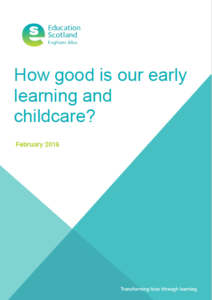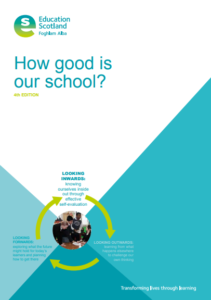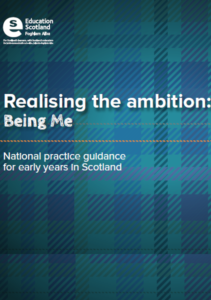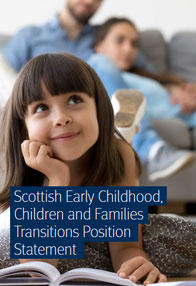Fluidity of Early Level
– Reflecting on Practice
QI 1.2 p14 Leadership of Learning – Level 5 illustration – Children Leading Learning
We make very good use of children’s ideas and interests to help shape the learning environment and experiences.
Children are consistently encouraged to choose and lead interactions in their own learning in play and in real-life contexts.
Children are becoming increasingly confident in interacting with others, discussing possibilities and reasoning out answers to a self-satisfying conclusion within an exciting range of indoor and outdoor learning experiences.
Taking very good account of children’s age and stage of development, practitioners are flexible and responsive in their approach as they encourage children to discuss and plan their learning, enjoy their successes and share their achievements
p15 Features of highly effective practice
Planning strongly reflects children’s ideas and interests and shows how practitioners very effectively respond to and promote their creativity, inquiry and curiosity
Practitioners have a clear understanding of how children learn. Their actions encourage high quality adult/child interactions.
QI2.2 p25 Curriculum – Rationale and design – Level 5 illustration
Our very good understanding of pedagogy and play in learning is evident in our delivery of the curriculum for babies, toddlers and the young child.
Our curriculum framework secures children’s wellbeing and rights including the right to play.
QI2.2 p26 Curriculum – Pedagogy and Play – Level 5 illustration
Our curriculum framework is based firmly on play and active learning.
In their practice, they demonstrate their deep understanding of the critical role of play in promoting children’s development and learning. There is a shared understanding in our setting of pedagogy and practitioners readily engage in debate and dialogue about ensuring high quality play. Children are provided with rich, relevant experiences to enhance their play and practise skills, explore the world around them and develop knowledge and understanding in their own way and in their own time. We provide innovative and creative opportunities for children to experience high quality play both indoors and outdoors. Our well timed and skilled interventions effectively promote children’s creativity, extend their thinking, widen their skills and consolidate their learning in play.
p27 Features of highly effective practice
All practitioners have a sound understanding of the importance of play and their role in supporting children’s play experiences
Challenge questions
Are children regularly involved in evaluating their play experiences and can they describe what they are learning? What do we do with this information? What changes could we make to use this more effectively?
QI2.3 p28 Learning, teaching and assessment – Learning and engagement – Level 5 illustration
Children enjoy and are actively involved in learning through spontaneous play opportunities, well-planned, purposeful play and through relevant real-life experiences.
p29 Challenge questions
To what extent do our learning environments support different types of play?
QI2.6 p35 Transitions – Continuity and Progression in Learning – Level 5 illustration
We use planned opportunities with others, including other practitioners and parents/carers, to develop a shared understanding of progress and play– based pedagogy across the early level.
p36 Features of highly effective practice
Information about children’s learning, and achievements, particularly in key areas of early literacy, numeracy and health and wellbeing, is used effectively to ensure continuity in learning across the curriculum for all children.
Planned opportunities enable practitioners to come together to develop a shared understanding of progress and pedagogy at all stages and across the early level.
QI3.3 p45 Developing creativity and skills for life and learning – Developing Creativity – Level 5 illustration
Creativity is at the heart of play and all aspects of learning
We ensure that children access open-ended play materials to extend their creativity and thinking. Our indoor and outdoor learning environments and engagement with the natural world offer regular high quality experiences that enable children to explore ideas and materials and to use their imagination freely.
Children have freedom to develop their play and interests and to deepen their learning. They confidently lead aspects of their own learning. High quality play enables children to explore possibilities, plan, design and evaluate solutions as they apply their skills across learning.
Developing skills for life and learning
Children persevere with their play and show high levels of self-esteem and self-belief when learning alone and increasingly with others.
p46 Features of highly effective practice
Through exploratory play, all children have the opportunity to develop and apply investigative, problem solving and thinking skills.
Approaches to learning and teaching enable children to become immersed in activities that interest them and to play for extended periods. Practitioners take care not to rush children.
Children’s experiences provide opportunities to play and learn together, share ideas, reconcile differences and develop a sense of fairness.
Challenge questions
How well are natural materials and open-ended resources used to support sensory play, exploratory play and creativity?
In what ways and to what extent do children make choices and decisions about their play and learning?
QI 1.2 p23 Leadership of Learning – Challenge question
What strategies are we using to develop resilience and confidence in our learners to lead their own and others learning?
To what extent do we support children and young people to take responsibility for their own learning and progress?
QI 2.2 p34 Curriculum – Level 5 illustration
Learning pathways support children and young people to build on their prior learning and ensure appropriate progression for all learners.
Learning pathways are based on the experiences and outcomes and design principles of progression, coherence, breadth, depth, personalisation and choice, challenge and enjoyment and relevance.
We ensure children and young people have access to high-quality learning in all curriculum areas and through outdoor learning.
p35 Features of highly-effective practice
Planning for progression in children and young people’s learning is in place for the four contexts and shows how knowledge, understanding and skills are built over time.
Outdoor learning is a regular, progressive curriculumled experience for all learners.
Challenge question
How well are children and young people involved in planning and identifying opportunities for personalisation and choice? 4 Is the level of personalisation and choice improving outcomes for children?
Is the entitlement of learners to Learning for Sustainability being met?
QI2.3 p36 Learning, teaching and assessment – Level 5 illustration
Learners’ experiences are appropriately challenging and enjoyable and well matched to their needs and interests.
We observe learners closely to inform appropriate and well-timed interventions and future learning.
Learners are fully involved in planning learning.
p37 Features of highly effective practice
The learning environment is built on positive, nurturing and appropriately challenging relationships which lead to high-quality learning outcomes.
Learners’ achievements in and out of school are recorded and recognised.
Staff access and apply relevant findings from educational research to improve learning and teaching.
Learners play an active role in the school and wider community and regularly take on leadership roles, including leading learning.
Learners receive high-quality feedback and have an accurate understanding of their progress in learning and what they need to do to improve.
Challenge questions
How well are learners enabled to select and make use of high-quality resources?
How well do we use our community and spaces to deliver high-quality outdoor learning?
QI 2.6 p43 Transitions – Features of highly-effective practice
Transition arrangements
p82 Section 7: Ensuring quality through critically reflective practice
What quality looks like; creating a setting / classroom that:
- Has a clear shared vision
- Have practitioners with an understanding of child development and how young children learn
- Rich adult-child interactions
- Understands the importance of curriculum and pedagogy
- Work with families and value children’s learning at home
Have a skilled workforce who engage in:
- Continuous learning and development
- Reflection on practice in the setting; looking outwards to collaborate and learn from others
Practitioners in high quality provision:
- Highly value and promote child initiated experiences
- Tune in to child initiated activity and sensitively intervene Extend learning based on an understanding of developmental stage and interests
- Enable children to lead their own learning
p46
The learning environment in the early stages of primary school should not look or feel starkly different from a motivating ELC environment. The level of provocation might be greater, the interaction might be more challenging, and the experiences on offer might be different, but the school environment should be conducive to learning through play”.
p7
Children are active in their own transitions and are entitled to continuity of relationships, play, learning, curriculum, resources and environments which are responsive to their needs and rights. They need to have their previous experience and contribution recognised in any new setting, building on what has gone before.






